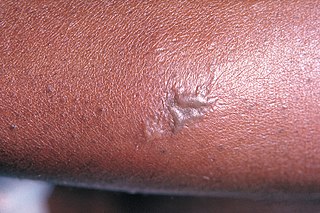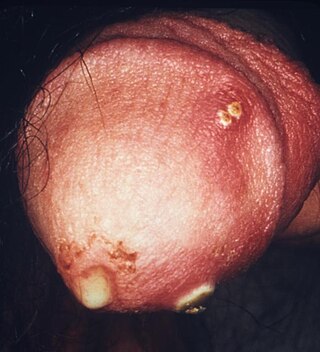
Fellatio is an oral sex act involving a person stimulating the penis of another by using the mouth. Oral stimulation of the scrotum may also be termed fellatio, or colloquially as teabagging.

Safe sex is sexual activity using methods or contraceptive devices to reduce the risk of transmitting or acquiring sexually transmitted infections (STIs), especially HIV. "Safe sex" is also sometimes referred to as safer sex or protected sex to indicate that some safe sex practices do not eliminate STI risks. It is also sometimes used colloquially to describe methods aimed at preventing pregnancy that may or may not also lower STI risks.

A kiss is the touch or pressing of one's lips against another person or an object. Cultural connotations of kissing vary widely. Depending on the culture and context, a kiss can express sentiments of love, passion, romance, sexual attraction, sexual activity, sexual arousal, affection, respect, greeting, peace, and good luck, among many others. In some situations, a kiss is a ritual, formal or symbolic gesture indicating devotion, respect, or a sacramental. The word came from Old English cyssan, in turn from coss.

Frot or frotting is a gay sexual practice that usually involves direct penis-to-penis contact. The term was popularized by gay male activists who disparaged the practice of anal sex, but has since evolved to encompass a variety of preferences for the act, which may or may not imply particular attitudes towards other sexual activities. This can also be used as some type of foreplay.
Men who have sex with men (MSM) refers to all men who engage in sexual activity with other men, regardless of their sexual orientation or sexual identity. The term was created by epidemiologists in the 1990s, to better study and communicate the spread of sexually transmitted infections such as HIV/AIDS between all sexually active males, not strictly those identifying as gay, bisexual, pansexual or various other sexualities, but also for example male prostitutes. The term is often used in medical literature and social research to describe such men as a group. It does not describe any specific kind of sexual activity, and which activities are covered by the term depends on context. An alternative term, males who have sex with males is sometimes considered more accurate in cases where those described may not be legal adults.
In medicine, public health, and biology, transmission is the passing of a pathogen causing communicable disease from an infected host individual or group to a particular individual or group, regardless of whether the other individual was previously infected. The term strictly refers to the transmission of microorganisms directly from one individual to another by one or more of the following means:
Post-exposure prophylaxis, also known as post-exposure prevention (PEP), is any preventive medical treatment started after exposure to a pathogen in order to prevent the infection from occurring.

Oral sex, sometimes referred to as oral intercourse, is sexual activity involving the stimulation of the genitalia of a person by another person using the mouth. Cunnilingus is oral sex performed on the vulva while fellatio is oral sex performed on the penis. Anilingus, another form of oral sex, is oral stimulation of the anus.

Sexual health clinics specialize in the prevention and treatment of sexually transmitted infections.
Serosorting, also known as serodiscrimination, is the practice of using HIV status as a decision-making point in choosing sexual behavior. The term is used to describe the behavior of a person who chooses a sexual partner assumed to be of the same HIV serostatus to engage in unprotected sex with them for a reduced risk of acquiring or transmitting HIV/AIDS.

Ass to mouth is a slang term associated with the porn industry describing anal sex immediately followed by oral sex. The term is primarily used to describe a sexual practice whereby an erect penis is removed from a receptive partner's anus and then directly put into their mouth, or possibly the mouth of another.

Non-penetrative sex or outercourse is sexual activity that usually does not include sexual penetration. It generally excludes the penetrative aspects of vaginal, anal, or oral sex, but includes various forms of sexual and non-sexual activity, such as frottage, manual sex, mutual masturbation, kissing, or cuddling. Some forms of non-penetrative sex, particularly when termed outercourse, include penetrative aspects, such as penetration that may result from forms of fingering or oral sex.

Sexual activities involving women who have sex with women (WSW), regardless of their sexual orientation or sexual identity, can include oral sex, manual sex, or tribadism.

Condom effectiveness is how effective condoms are at preventing STDs and pregnancy. Correctly using male condoms and other barriers like female condoms and dental dams, every time, can reduce the risk of sexually transmitted infections (STIs), including human immunodeficiency virus (HIV) and viral hepatitis. They can also provide protection against other diseases that may be transmitted through sex like Zika and Ebola. Using male or female condoms correctly, every time, can also help prevent pregnancy.

Gonorrhoea or gonorrhea, colloquially known as the clap, is a sexually transmitted infection (STI) caused by the bacterium Neisseria gonorrhoeae. Infection may involve the genitals, mouth, or rectum. Infected men may experience pain or burning with urination, discharge from the penis, or testicular pain. Infected women may experience burning with urination, vaginal discharge, vaginal bleeding between periods, or pelvic pain. Complications in women include pelvic inflammatory disease and in men include inflammation of the epididymis. Many of those infected, however, have no symptoms. If untreated, gonorrhea can spread to joints or heart valves.

A sexually transmitted infection (STI), also referred to as a sexually transmitted disease (STD) and the older term venereal disease (VD), is an infection that is spread by sexual activity, especially vaginal intercourse, anal sex, oral sex, or sometimes manual sex. STIs often do not initially cause symptoms, which results in a risk of passing the infection on to others. Symptoms and signs of STIs may include vaginal discharge, penile discharge, ulcers on or around the genitals, and pelvic pain. Some STIs can cause infertility.

Cunnilingus is an oral sex act involving a person stimulating the vulva of another by using the tongue and lips. The clitoris is the most sexually sensitive part of the vulva, and its stimulation may result in a woman becoming sexually aroused or achieving orgasm.

Anilingus is an oral and anal sex act in which one person stimulates the anus of another by using their tongue or lips.
Sexually transmitted infections in the pornography industry deals with the occupational safety and health hazard of contracting sexually transmitted infections (STIs) by workers in the sex industry. Since the 1980s many cases of pornographic performers contracting HIV/AIDS have been reported. However, since the mid-2000s strict adherence to rigorous STI testing, and limiting sexual contact with only fellow tested performers has halted the spread of HIV and other STIs in the industry.

Penile discharge is fluid that comes from the urethra at the end of the penis that is not urine, pre-ejaculate or semen.















